英语专业翻译方向论文
- 格式:docx
- 大小:86.67 KB
- 文档页数:15
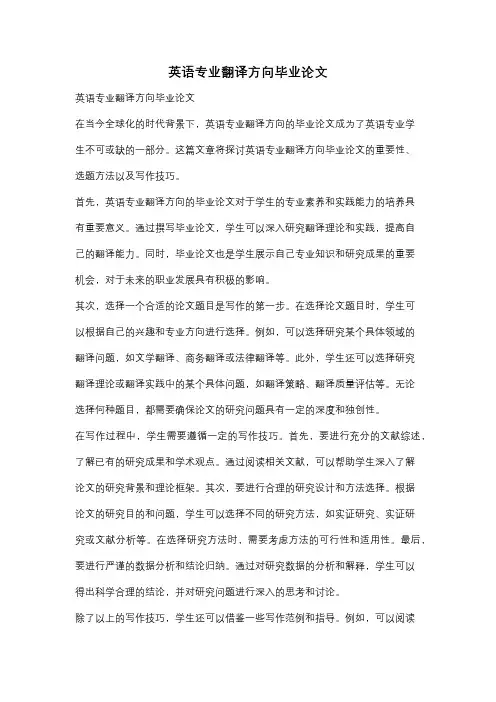
英语专业翻译方向毕业论文英语专业翻译方向毕业论文在当今全球化的时代背景下,英语专业翻译方向的毕业论文成为了英语专业学生不可或缺的一部分。
这篇文章将探讨英语专业翻译方向毕业论文的重要性、选题方法以及写作技巧。
首先,英语专业翻译方向的毕业论文对于学生的专业素养和实践能力的培养具有重要意义。
通过撰写毕业论文,学生可以深入研究翻译理论和实践,提高自己的翻译能力。
同时,毕业论文也是学生展示自己专业知识和研究成果的重要机会,对于未来的职业发展具有积极的影响。
其次,选择一个合适的论文题目是写作的第一步。
在选择论文题目时,学生可以根据自己的兴趣和专业方向进行选择。
例如,可以选择研究某个具体领域的翻译问题,如文学翻译、商务翻译或法律翻译等。
此外,学生还可以选择研究翻译理论或翻译实践中的某个具体问题,如翻译策略、翻译质量评估等。
无论选择何种题目,都需要确保论文的研究问题具有一定的深度和独创性。
在写作过程中,学生需要遵循一定的写作技巧。
首先,要进行充分的文献综述,了解已有的研究成果和学术观点。
通过阅读相关文献,可以帮助学生深入了解论文的研究背景和理论框架。
其次,要进行合理的研究设计和方法选择。
根据论文的研究目的和问题,学生可以选择不同的研究方法,如实证研究、实证研究或文献分析等。
在选择研究方法时,需要考虑方法的可行性和适用性。
最后,要进行严谨的数据分析和结论归纳。
通过对研究数据的分析和解释,学生可以得出科学合理的结论,并对研究问题进行深入的思考和讨论。
除了以上的写作技巧,学生还可以借鉴一些写作范例和指导。
例如,可以阅读一些优秀的毕业论文,了解其结构和写作风格。
此外,学生还可以参考一些学术写作指南,如《英语论文写作指南》等,了解学术写作的基本规范和要求。
通过学习和模仿优秀的写作范例,可以提高自己的写作水平和表达能力。
总之,英语专业翻译方向的毕业论文对于学生的专业素养和实践能力的培养具有重要意义。
选择一个合适的论文题目、遵循一定的写作技巧以及借鉴一些写作范例和指导,都是撰写一篇优秀毕业论文的关键。
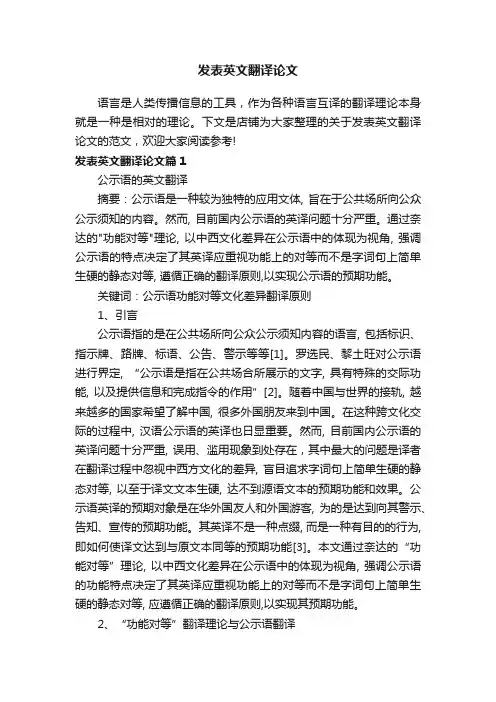
发表英文翻译论文语言是人类传播信息的工具,作为各种语言互译的翻译理论本身就是一种是相对的理论。
下文是店铺为大家整理的关于发表英文翻译论文的范文,欢迎大家阅读参考!发表英文翻译论文篇1公示语的英文翻译摘要:公示语是一种较为独特的应用文体, 旨在于公共场所向公众公示须知的内容。
然而, 目前国内公示语的英译问题十分严重。
通过奈达的"功能对等"理论, 以中西文化差异在公示语中的体现为视角, 强调公示语的特点决定了其英译应重视功能上的对等而不是字词句上简单生硬的静态对等, 遵循正确的翻译原则,以实现公示语的预期功能。
关键词:公示语功能对等文化差异翻译原则1、引言公示语指的是在公共场所向公众公示须知内容的语言, 包括标识、指示牌、路牌、标语、公告、警示等等[1]。
罗选民、黎土旺对公示语进行界定, “公示语是指在公共场合所展示的文字, 具有特殊的交际功能, 以及提供信息和完成指令的作用”[2]。
随着中国与世界的接轨, 越来越多的国家希望了解中国, 很多外国朋友来到中国。
在这种跨文化交际的过程中, 汉语公示语的英译也日显重要。
然而, 目前国内公示语的英译问题十分严重, 误用、滥用现象到处存在,其中最大的问题是译者在翻译过程中忽视中西方文化的差异, 盲目追求字词句上简单生硬的静态对等, 以至于译文文本生硬, 达不到源语文本的预期功能和效果。
公示语英译的预期对象是在华外国友人和外国游客, 为的是达到向其警示、告知、宣传的预期功能。
其英译不是一种点缀, 而是一种有目的的行为, 即如何使译文达到与原文本同等的预期功能[3]。
本文通过奈达的“功能对等”理论, 以中西文化差异在公示语中的体现为视角, 强调公示语的功能特点决定了其英译应重视功能上的对等而不是字词句上简单生硬的静态对等, 应遵循正确的翻译原则,以实现其预期功能。
2、“功能对等”翻译理论与公示语翻译公示语作为一个信息时代和经济全球化时代的标志之一, 公开面对公众, 给予公众行为需求的文字信息传递。
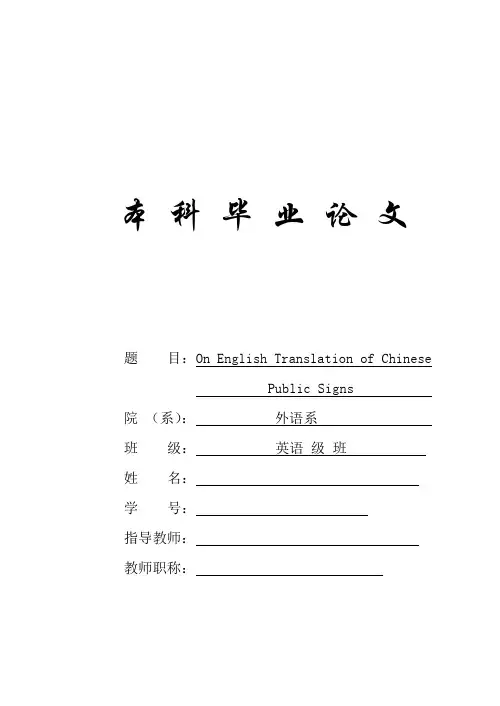
本科毕业论文题目:On English Translation of ChinesePublic Signs 院(系):外语系班级:英语级班姓名:学号:指导教师:教师职称:汉英公示语的翻译摘要公示语向来被称作“城市的脸孔",是给所有到中国来的外国人士留下第一印象的中国名片。
然而,公示语翻译的错误比比皆是,这大大影响了公示语作用的发挥,削弱了我国的国际形象。
为了树立我国良好的国际形象,不断规范和完善城市公示语的翻译成为了一项亟待完成的工作。
基于以上原因,作者尝试从理论和实践的角度分析现今汉英公示语翻译中所存在的一些问题。
通过对大量标准以及问题公示语翻译的深入观察分析,作者对公示语的一般特征进行了总结并对公示语翻译中出现的问题进行了分类,从而在实践观察和对相关理论深入研究的基础上提出相应的翻译策略。
翻译并不仅仅是跨语言行为,它更是一种文化信息的传递。
公示语的翻译同样如此。
得体的公示语翻译不仅在语言上要无懈可击,在文化信息传递上也要雅俗共赏。
本文还对公示语的概念做出了解释,并根据目的需求与功能两种标准对公示语做了分类。
在介绍公示语的特征时,作者将其分为语言特征与功能特征,特征与分类不同,也决定了需要采取不同的翻译策略。
关键词:汉英翻译;公示语;问题;翻译策略On English Translation of Chinese PublicSignsAbstractPublic signs, which have alway s been referred to “face of city”, are the first impression of China for the people who come to China. However, the ubiquitous translation mistakes of public signs greatly undermine the international image of China. So,specificating and constantly perfecting the translation of public signs have become an urgent work in order to establish a good international image.The paper ventures an attempt to analyze the current problems existing in the C-E translation of public signs and to seek proper translational strategies both from the perspectives of theory and practice.By closely observing numerous samples of both standard and problematic translation of signs,the author manages to generalize the characteristics of public signs and to categorize the problems and mistakes in the current C-E translation of public signs.Then, proper translational strategies are proposed on the basis of in-depth study of relevant theories and keen observation of practice.Translation is not merely a cross-linguistic activity, but more of a transmission of cultural information.The translation of public signs is no exception.An appropriate translation of public sign should not only belinguistically correct, but also culturally acceptable.This paper expresses the meaning of the public signs and classify the signs according to the standards of objective demand and function. And the characteristics of the public signs are different studied from linguistic features and functional features,which determines to adopt different translation strategies.Key words: Chinese-English translation public sign problems translation strategyContents摘要 (I)Abstract (II)CHAPTER I Introduction (1)1.1 O bjective of the study (1)1.2 Significance of the study (1)1.3 Structure of the paper (2)CHAPTER II General Introduction to Public Signs (3)2.1 Definition of Public Signs (3)2.2 Functions of Public Signs (3)2.2.1 Directing function (4)2.2.2 Prompting function (4)2.2.3 Restricting function (4)2.2.4 Compelling function (5)CHAPTER III Analysis on Problems in C-E Translation of Public Signs (6)3.1 Linguistic translation problems (6)3.1.1 Spelling errors (6)3.1.2 Grammatical errors (6)3.1.3 Wrong dictions (7)3.2 Cultural translation problems (7)CHAPTER IV Strategies of C-E Public Signs Translation and Requirementfor Translator (9)4.1 Principles of C-E translation of Public Signs (9)4.1.1 Clearness (9)4.1.2 Conciseness (10)4.1.3 Simple words (10)4.2 Methods of C-E translation of Public S igns (11)4.2.1 Modification (11)4.2.2 Addition (11)4.2.3 Omission (12)4.2.4 Mutual transformation of affirmative and negativee xpressions (13)4.3 Requirement for the t ranslators (13)CHAPTER V Conclusion (15)Acknowledgements (16)Works Cited (17)CHAPTER I Introduction1.1Objective of the studyThe research objective of the study is to examine the translation problems in the Chinese-English public signs translation and further propose the translation strategies as well as principles suitable for specific groups.The studies begin with the careful and long period of observation of the problems existing in the public signs translation. On the basis of the classification of the translation errors proposed by Christiane Nord, the author aims at the most appropriate translation strategies for each type. With the examination of sufficient sources, the author finds that it is not difficult to eliminate the errors at linguistic level since the text of the public signs is less complex than documentary and other instrumental texts due to its conciseness and directness features (Ni 18).1.2 Significance of the studyPublic S igns affect people’s life in a tremendous way. When somebody smokes, it is the public sign that stops him. In fascinating and mysterious spots where we have never been to, it is the public sign that teaches us related knowledge. Foreign visitors from all walks of life,such as entrepreneurs,professors,students and tourists come to China for various purposes.But for most of them,they know little about Chinese.In this case,it is necessary to translate Chinese public signs into English for the convenience of these foreign visitors.In this case, a proper translation helps establish a good image of China and enhance the cultural communication.1.3 Structure of the paperThe paper is structured with five chapters:The first chapter is a general introduction to the thesis, including the objective of the study, the structure of the thesis and the significance of the study. The second chapter makes a general introduction to public sign, including the definition and functions of public sign. The third chapter focuses on the problems of C-E translation of public signs from linguistics and cultural perspectives. The fourth chapter deals with translation strategies of C-E public signs in connection with principles, methods and the standardization for the translators, including modification, addition, omission and mutual transformation of affirmative and negative expressions. And the fifth chapter draws a conclusion to the paper,in which the author appeals for translators and scholars to make contributions to the C-E translation of public signs.CHAPTER II General Introduction to Public Signs2.1 Definition of Public SignsPublic Signs,which are usually called“signs”,include public notices,advertisements,slogans and expressions on the public signs.Public signs refer to “signs” in English and are defined in different ways.Ac cording to Longman Dictionary of Contemporary English(1997),a sign is a piece of paper, metal, or wood with words or a picture that gives information,warnings,or instructions.In that sense, public sign is the general terms for indicators,signs,traffic signs, posters, slogans, warning, short notices,short instructions,stickers,and are becoming the catch word and the buzzword.All in all, public signs are so widely used and played important roles in our daily life.2.2 Functions of Public SignsPublic signs are essential to the normal operation of the society and their influence is also visible in almost every aspect of our daily life.Sometimes,we have to admit that our lives cannot do without the proper guidance that public signs provide to us.However, what usually happens is that we are prone to be bewildered by various public signs and the enormous information they convey to us.Therefore, it would be necessary to classify the public signs in terms of their functions as well as the status of information that they deliver.2.2.1 Directing functionDirecting is the most basic function of public signs, t his type of public signs is used to give readers related information about what the institution is,what it deals with and what kind of service it can provide.For example:Take Away(外卖),Gas Station(加油站),Emergency Exit(紧急出口),Business Hours(营业时间),Pause(暂停),Menu(菜单),Airport Security(机场安检).From the examples above we may tell that the language and the tone of these public signs are generally neutral,reflecting no attitude towards receptors.Therefore,public signs of this kind are purely informative rather than vocative.2.2.2 Prompting functionPromoting signs are similar to the directive ones in their informative function. While the difference is the former .carries the tone of warning,reminding the readers to pay some attention to certain things or activities.For example:Keep Clear(请保持清洁), Keep Silence(请保持安静),Wet Paint(油漆未干),Fully Booked(客满),Beware of Pickpockets(小心扒手),Maximum Height(限高).2.2.3 Restricting functionPublic Signs with restricting function impose restriction or even prohibition on receptors.The language used in this kind of signs are simple and direct but are not in rude,tough or impolite way.We can list some of them as following:Pay In Cash(现金支付),Slow Out(减速慢行),Keep Silence(保持安静),30 Minutes Parking(限停30分钟),Seat By Number(对号入座), Stand In Line(排队等候).2.2.4 Compelling functionCompelling function is the strongest considerable mood.It is used to prohibit the readers to do something or must do something.The language used is usually forceful,with no possibility of making a compromise.The sign with this function which we mostly often see is“No Smoking禁止吸烟”,that is to say that smoking iscompletely forbidden.Imperative sentence is not enough to express this strong mood,usually, we use“No+…”form,for example,“No Food禁止携带食物”.More examples:Don’t Touch(禁止触摸),No Cameras(禁止拍照),No Visitors(游客止步),No Trucks(卡车禁止通行),Dogs Not Allowed(禁止带狗入内).Translation of the public signs, translators not only need to grasp their function features since we use different mood to express different function,but also should keep their language features in mind during the translating.CHAPTER III Analysis on Problems in C-E Translation ofPublic Signs3.1 Linguistic translation problemsLinguistic translation errors are often due to deficiencies in the translator's source or target language competence (Nord 77).And in his book Pragmatics and English Language He Ziran explained that by making linguistic errors,the translators and interpreters fail to conform to the target language structures,instead they blindly translate the source text in their own language structures(157).Professor Wang Yinquan, classifies linguistic translation errors into: spelling mistakes, grammar mistakes and wrong diction (32).3.1.1 Spelling errorsSpelling errors are typical translation problems in bilingual public signs. The reasons for this type of errors attribute to the three factors: the incompetent language acquisition, the laziness of the translator when writing, the uncertainty of the correct spelling, among which the third type is most difficult to be identified. For example: 3.1.2 Grammatical errorsApart from spelling mistakes,many grammatical errors also occur in the translated signs.These errors appear in various forms,most of which result from the translator’s poor command of the English language or irresponsible working attitude.As a result,the translated public signs cannot be of any help to the target readers.Sometimes they may do damage the image of our city.For example: 室内停车场(Car Park)—It may be apparent to tell that the translator intends to use the word“park”as a noun to express the meaning of parking place for automobiles.However, as a noun the word actually means a public place wherepeople can entertain themselves with the landscape or public facilities in it.Therefore, it will be advisable to use the gerund form of the word “park”and translate it as“Indoor Parking”.3.1.3 Wrong dictionsWrong Dictions occur when t he translator doesn’t make right choices of words in the target culture that will lead to unsuccessful expression of the correct information to the target text receivers. In fact, many English words have more than one meaning. Sometimes one word used to describe the source culture may not be applicable in another situation and the diction is conditioned. The words chosen for each text might vary according to different semantic and syntactic features in different situations. For example:请勿采摘花朵--Please Don’t Pick Flowers. Here use“pick”to describe the gesture. In fact, there is a variety of expression in English corresponding with “摘”, of which one of the expressions is “pick”. But in the given circumstances, “pick”doesn’t equate with “摘”. “Pick”means to select among a variety of choices, but here the sender wants to persuade people not to pluck the flowers. The error is due to the confusion about the seemingly identical usage of one word.3.2 Cultural translation problemsAs we all know, people in different cultures may view the same thing in different ways and differ in the perspective of cognition.At the same time,they express the same idea in different way.As far as Chinese and English are concerned, culture differences are tremendous.Translation breaks down language barriers and thus realizes communication between cultures using different languages. In this sense, target readers approach to people of source culture whose beliefs, backgrounds, perception of the world are distinct from their own.For example:古装照相It is ancient to pack photo“古装照相”is a typical Chinese term. In English, people don’t have the correspondent term. According to the public signs translation convention, the signs which are composed of Chinese noun phrases are expected to have the same structure in English version, so the sentence is not correct in terms of the sentence structure. Also concerning the meaning of the sentence, it is wrongly translated that the foreigners can’t get the message which leads to the pragmatic failure of the assumed function. The correct version should be “Photos in ancient costume”.CHAPTER IV Strategies for C-E Public Signs Translation4.1 Principles of C-E translation of Public SignsAs we know, different functions need different language forms to convey and each language style possesses its special principles.Ni Chuanbin and Liu Zhi analyze the language principles of public signs in their essay“The Principles for C-E Translation of Public Signs and its Cases Study”,published in Shanghai Journal of Translators for Science and Technology(18).Firstly, the signs are on a board,so the language on the signs should be in concise way due to the comparatively small space.Secondly, some public signs must draw the public’s attention at the first sight and the readers can catch its meaning very quickly and correctly, especially the traffic signs,such as“Abrupt Turn Left Ahead前方急转弯”,the applied words should be simple ones instead of rare ones.At last,the meaning of the signs should be clear and easy to read,the sign is set without ambiguity. So we can know the principles in details as following:4.1.1 ClearnessDue to the short time the target reader can spend on reading the signs the meaning of the signs should be clear and easy to be understood.As the target readers are the common people who have little knowledge related to the concerned topic,the signs should directly hit the point and there should exist no vagueness.“严禁客货混装Don’t put passengers and cargos together”. It is hazy and not clearness. So the sign“严禁客货混装”should be translated into“No passengers on Trucks”.The signs are set for the public and not every reader is professional,therefore when we translate signs,we should hit the point directly and clearly and should notjust talk around the bush.4.1.2 ConcisenessAccording to William Strunk,Jr.and E.B.White in 1979(Joan Pinkham):“Vigorous writing is concise.A sentence should contain no unnecessary words,a paragraph no unnecessary sentences,for the same reason that a drawing should have no unnecessary lines and a machine no unnecessary parts.”It is also true of language of public signs.Usually, the readers for public signs just give a quick look at the board with signs on when they pass by.So the language on it need not be in a complete sentence,a phrase or just a word is enough,for example,“No Smoking禁止吸烟”,“Open正在营业”,we need not use sentences“Please do not smoke”an“We are on business”.4.1.3 Simple wordsPublic Signs are set for the public,target readers of this kind of materials are ordinary people,not only the native English speakers,but also other foreigners who know a little English and English is not his mother language,and target readers also include overseas Chinese who is not a English native speaker.If the English version is full of rare words and expression,it will cause a pragmatic failure of communication for public signs.There is always a small restaurant at the airport to provide fast food for the passengers,the English tablet should be“Snacks”instead of“Refection”,the later one is not often be used nowadays and we cannot find it in the dictionaries published in recent years.Take all another example,“景区环境卫生,需要您的维护”,should we translate it into“Environmental Sanitation of the Scenic Spot Needs Your Conserve”? The words“sanitation”and“environmental”are not familial words for the public,we had better use“Keep Clear”or“No Littering”.From the above,in order to make target readers catch the meaning at first glance,we should use the concise,clear, simple words and expressions in C-E translation of public signs.4.2 Strategies of C-E translation of Public Signs4.2.1 ModificationGenerally speaking, it is always the case that the reader in the culture of the target language may not share the cultural background of the source language.Therefore,when dealing with culture-loaded words and idioms,the translator sometimes has to make cultural modification so as to generate the same feedback from the target text reader with that of the source text reader, and as for the translation of public signs, it is no exception.For examples:西湖的虎跑泉—Tiger Running Spring, in this public sign,the translator obviously take the actual meaning of the sign for granted by translating the word“虎跑”as“tiger running”which means that a tiger runs for the spring.4.2.2 AdditionSome public signs,especially signs at scenic spots,tend to include dynasties,legends or other cultural elements,while most foreign visitors lack the background knowledge of China.If the public signs are translated literally, the English versions may confuse the target readers.Thus we should adopt the translation strategy of addition to supply necessary information on the basis of accurate comprehension of the original public signs.For example:谢绝游客入内Closed To Visitors禁止在墙上涂写No Scribbling On The Wall4.2.3 OmissionDue to different aesthetic standards and cultures,Chinese writing tends to include flowery words,four-word phrases or some culture elements which are special to the Chinese culture.However, English writing pursues clear and simple expressions.In How to Help Foreigners Know China,Duan Liancheng holds a view that with the development of tourism in recent years,large numbers of brochures pamphlets and pictorials have been published for foreign tourists.A common weakness of these materials is full of flowery words and cultural elements of China which may confuse the target readers (Duan 286). So the translator should omit some adjectives or cultural elements which may pose barriers to the target readers.Then the English version will be easily understood by them.For example:1.Source Text:慢速行驶Version A:You must drive slowly.Version B:Drive slowly2.Source Text:前方学校Version A:There is a school ahead.Version B:School Ahead4.2.4 Mutual transformation of affirmative and negative expressionsMutual transformation of affirmative and negative expressions is a common strategy in translating the text of one language to the other.It is especially useful for transcending the translational difficulties due to different ways or habits of expressing ideas in Chinese and English.In translating public signs,mutual transformation of affirmative and negativeexpressions is necessary as well.In western countries especially in English—speaking countries,people tend to avoid using negative expressions in public literatures as much as possible in case that unpleasant emotion or feeling would be aroused on the part of the receptor.However, because of the difference in cultural values,negative expressions are more frequently used in Chinese public signs.Therefore,according to the theory of cultural translation, we should adopt the translational method of“Domestication”.For example: “社会车辆禁止入内”,it is a kind of negative expression in Chinese language. While it should be translated into “Staff Only” in English, it is affirmative.4.3 Requirement for the translatorsThe C-E translation of public signs is by no means an easy job and it requires that a translator be serious and accountable in attitude, and proficient in both the source and the target languages at the same time.A good translator should always bear in mind the features and characteristics of public signs.Only if the translators acquire the expertise in the source and target languages as well as the source and target cultures can they produce qualified versions. In addition, as for the making process of signs, the local governments should choose reliable and efficient sign-making units by means of bidding to undertake the job.And the translation should be tested in the foreigners to ensure the acceptability.Then a supervision organization in charge of public signs should be established to make sure that some common English versions are accurate and unified.CHAPTER V ConclusionBased on the previous discussions and analyses, the major findings of this study can be summarized as follow:Firstly, the linguistic translation problems account for the reasons for spelling, grammatical and wrong dictions problems. Translators should improve their language acquisition in dealing with the problems.Secondly, as to cultural problems, the translators are advised to adopt communicative translation. To be more specific, the translation strategies are adaptation, restructuring, semi-literal translation, etc.Thirdly, the C-E translation involves the principles and the methods. The principles include three points of clearness, conciseness and simple words. The translation takes place in a given situation or in another sense, the methods of C-E translation of public signs should be divided into four: modification, addition, omission and mutual transformation of affirmative and negative expressions.Actually, the problems of the translation of public signs are far more complicated than the thesis.The problems that have been discussed and proposed with strategies to are just a tiny tip of the whole iceberg.With the development of the society, it is sure that more and more public signs will come out by taking various forms,and new problems in translating them will turn up.Therefore,the classification of public signs and mistranslation, as well as the strategies for the betterment of the current status of sign translation, although the author attempts to let them be, are not all-inclusive and universally accurate. It is a long and hard way for us to go.AcknowledgementsI would like to express my heartfelt thanks to those who offered me their sincere support and encouragement in the process of my thesis writing.First of all, I’d like to give my sincere thanks to my teacher, Kangbing. She has given me valuable instructions on my study. Whenever I need her help, she always enthusiastically offers me. During the process of the completion of the thesis, from the researches chosen to be analyzed to the final composition, her patient and helpful instructions have benefited me a great deal. Her strict requirements have enabled me to learn how to do research work, and her kind encouragement have been supporting me to the end.Second, my true thanks also go to all the teachers who guide me in the field of business English.Finally, my family and friends give me great encouragement and support during the composition of the thesis. I’d like to send them my heartfelt thanks too.Work CitedBaker, Mona. Encyclopedia of Translation Studies[M]. Shanghai: Shanghai Foreign Language Education Press, 2004:104.Nida, Eugene A.&C. R. Taber. The Theory and Practice of Translation[M]. Leiden:E.J. Brill, 1969:89-97.Nord, Christiane. Translating as a Purposeful Activity[M]. Shanghai: Shanghai Foreign Language Education Press, 2001:77.Pinkham John.The Translator’s Guide to Chinglish[M].Beijing:Foreign Language Teaching and Research Press, 2000:99.Snell-Hornby, Marry. Translation Studies: an Integrated Approach[M]. Shanghai: Shanghai Foreign Language Education Press, 2001:267-271.Wilss,Wolfman.The Science of Translation-Problems and Methods[M].Shanghai:Shanghai Foreign Language Education Press, 2001:125.包惠南.文化语境与语言翻译[M]. 北京:中国对外翻译出版公司, 2002:78-86. 陈定安.英汉比较与翻译[M]. 北京:中国对外翻译出版公司, 1988:271-275. 陈淑莹.标示语英译的语用失误探析[J]. 四川外语学院学报, 2006 ,1:117-120.戴宗显, 吕和发. 公示语汉英翻译研究---以2012年奥运会主办城市伦敦为例[J]. 中国翻译, 2005,6:38-42.何自然.语用学概论[M].长沙:湖南教育出版社,1988:157.赖少华.浅谈公示语的翻译现状及对策----以广州地铁站公示语翻译为例[J].湖北广播电视大学学报, 2009,6:112-112.吕和发, 单丽平.汉英公示语词典[M]. 北京: 商务印书馆, 2004:38..倪传斌,刘治.标记语的英译原则及实例分析[J].上海科技翻译, 1998,2:18-20.单爱民.谈英语公示用语的语言特点与汉英翻译[J]. 北京第二外国语学院学报, 2002,5:76-79.王晓娟. 从功能理论看公示语翻译---以南京城市公示语为例[J]. 湖北经济学院学报:人文社会科学版, 2008,4:119-120.。

石河子大学毕业论文题目:如何处理英翻汉中的省略How to Deal with Ellipsis inEnglish-Chinese Translation院(系):外国语学院专业:英语班级:20095学号:2009051431姓名:指导教师:完成日期: 2013年5月6日ContentsI. Introduction (1)II. Literature Review (2)III. The Principles of Ellipsis (4)A. Omitted words must be useless and unnecessary in the translated works. (5)B. The meaning of the omitted words is implied in the test. (5)C. Omitted words are self-evident. (5)IV. The functions and application of ellipsis (5)A. The Coherence of the Meaning of Expression (6)B. The Coincidence of the Manner of Expression (6)1. Ellipsis of Articles (6)2. Ellipsis of Prepositions (7)3. Ellipsis of Pronouns (7)a. Ellipsis of Personal Pronouns (7)b. Ellipsis of Impersonal Indefinite Pronouns (8)c. Ellipsis of Relative Pronouns (8)4. Ellipsis of Conjunctions (9)a. Ellipsis of Coordinating Conjunctions (9)b. Ellipsis of Subordinate Conjunctions (9)5. Ellipsis of Rhetorics (9)V. Conclusion (10)Works Cited (11)AbstractWith the development of globalization, the world's political, economic and cultural communications are becoming increasingly frequent. Meanwhile, the role of translation cannot be ignored. Due to language and cultural disparity, reasonable translation is particularly important. How to deal with ellipsis in translation is one of the important aspects. The paper will explore ellipsis in English-Chinese translation from five aspects, which are ellipsis of pronouns, conjunctions, articles, prepositions, modifications, so as to achieve the purpose of smoother and clearer communication among China and English-speaking countries.Key words: cultural disparity; translation; ellipsis摘要随着全球化的不断发展,各国之间的政治、经济、文化交流日渐频繁。
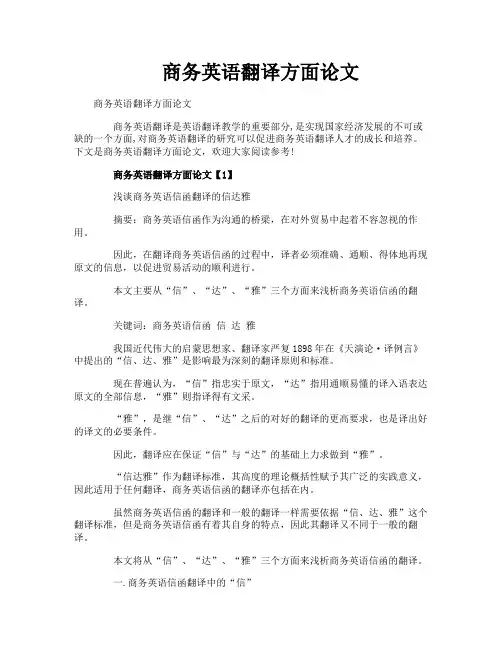
商务英语翻译方面论文商务英语翻译方面论文商务英语翻译是英语翻译教学的重要部分,是实现国家经济发展的不可或缺的一个方面,对商务英语翻译的研究可以促进商务英语翻译人才的成长和培养。
下文是商务英语翻译方面论文,欢迎大家阅读参考!商务英语翻译方面论文【1】浅谈商务英语信函翻译的信达雅摘要:商务英语信函作为沟通的桥梁,在对外贸易中起着不容忽视的作用。
因此,在翻译商务英语信函的过程中,译者必须准确、通顺、得体地再现原文的信息,以促进贸易活动的顺利进行。
本文主要从“信”、“达”、“雅”三个方面来浅析商务英语信函的翻译。
关键词:商务英语信函信达雅我国近代伟大的启蒙思想家、翻译家严复1898年在《天演论·译例言》中提出的“信、达、雅”是影响最为深刻的翻译原则和标准。
现在普遍认为,“信”指忠实于原文,“达”指用通顺易懂的译入语表达原文的全部信息,“雅”则指译得有文采。
“雅”,是继“信”、“达”之后的对好的翻译的更高要求,也是译出好的译文的必要条件。
因此,翻译应在保证“信”与“达”的基础上力求做到“雅”。
“信达雅”作为翻译标准,其高度的理论概括性赋予其广泛的实践意义,因此适用于任何翻译,商务英语信函的翻译亦包括在内。
虽然商务英语信函的翻译和一般的翻译一样需要依据“信、达、雅”这个翻译标准,但是商务英语信函有着其自身的特点,因此其翻译又不同于一般的翻译。
本文将从“信”、“达”、“雅”三个方面来浅析商务英语信函的翻译。
一.商务英语信函翻译中的“信”翻译应当忠实于原文,这是翻译最基本的要求。
因为若译得不准确,轻则就会招来内行人笑话,或产生误解,引起对方不快,重则就会误事,给工作带来损失,甚至会产生严重后果。
商务英语信函作为涉外商务活动中传递信息和洽谈业务的主要手段,其翻译更应遵循“信”这一标准。
1.内容准确完整在翻译商务英语信函时,译者应当准确、忠实地再现原文信函的内容,翻译时不要漏译,要完整地把信息表达出来,使读者能够明白信函的真正意图。
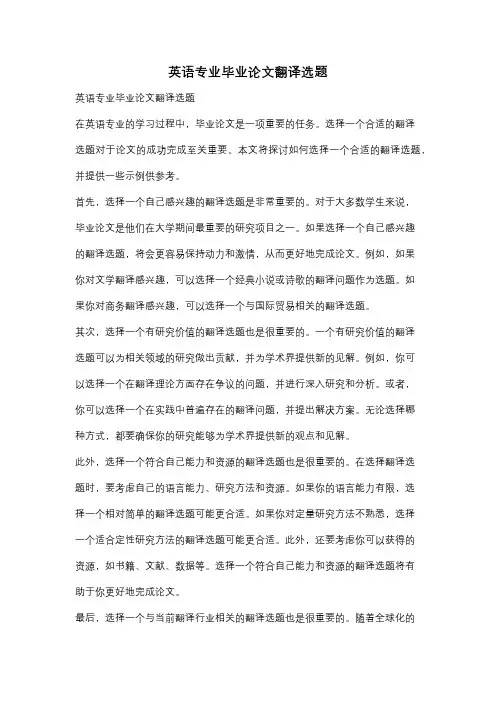
英语专业毕业论文翻译选题英语专业毕业论文翻译选题在英语专业的学习过程中,毕业论文是一项重要的任务。
选择一个合适的翻译选题对于论文的成功完成至关重要。
本文将探讨如何选择一个合适的翻译选题,并提供一些示例供参考。
首先,选择一个自己感兴趣的翻译选题是非常重要的。
对于大多数学生来说,毕业论文是他们在大学期间最重要的研究项目之一。
如果选择一个自己感兴趣的翻译选题,将会更容易保持动力和激情,从而更好地完成论文。
例如,如果你对文学翻译感兴趣,可以选择一个经典小说或诗歌的翻译问题作为选题。
如果你对商务翻译感兴趣,可以选择一个与国际贸易相关的翻译选题。
其次,选择一个有研究价值的翻译选题也是很重要的。
一个有研究价值的翻译选题可以为相关领域的研究做出贡献,并为学术界提供新的见解。
例如,你可以选择一个在翻译理论方面存在争议的问题,并进行深入研究和分析。
或者,你可以选择一个在实践中普遍存在的翻译问题,并提出解决方案。
无论选择哪种方式,都要确保你的研究能够为学术界提供新的观点和见解。
此外,选择一个符合自己能力和资源的翻译选题也是很重要的。
在选择翻译选题时,要考虑自己的语言能力、研究方法和资源。
如果你的语言能力有限,选择一个相对简单的翻译选题可能更合适。
如果你对定量研究方法不熟悉,选择一个适合定性研究方法的翻译选题可能更合适。
此外,还要考虑你可以获得的资源,如书籍、文献、数据等。
选择一个符合自己能力和资源的翻译选题将有助于你更好地完成论文。
最后,选择一个与当前翻译行业相关的翻译选题也是很重要的。
随着全球化的发展,翻译行业正变得越来越重要。
选择一个与当前翻译行业相关的翻译选题将有助于你了解行业的最新发展和趋势。
例如,你可以选择一个与机器翻译或自然语言处理相关的翻译选题,以了解这些新技术对翻译行业的影响。
或者,你可以选择一个与跨文化沟通或语言服务行业相关的翻译选题,以了解这些领域的最新研究和实践。
综上所述,选择一个合适的翻译选题对于英语专业毕业论文的成功完成非常重要。
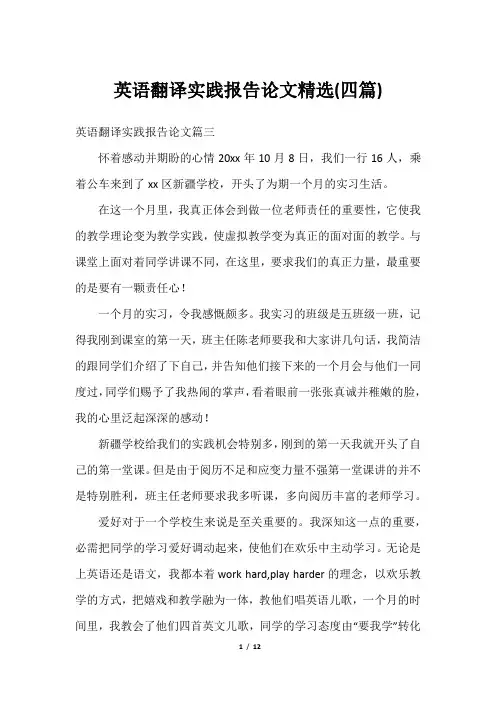
英语翻译实践报告论文精选(四篇)英语翻译实践报告论文篇三怀着感动并期盼的心情20xx年10月8日,我们一行16人,乘着公车来到了xx区新疆学校,开头了为期一个月的实习生活。
在这一个月里,我真正体会到做一位老师责任的重要性,它使我的教学理论变为教学实践,使虚拟教学变为真正的面对面的教学。
与课堂上面对着同学讲课不同,在这里,要求我们的真正力量,最重要的是要有一颗责任心!一个月的实习,令我感慨颇多。
我实习的班级是五班级一班,记得我刚到课室的第一天,班主任陈老师要我和大家讲几句话,我简洁的跟同学们介绍了下自己,并告知他们接下来的一个月会与他们一同度过,同学们赐予了我热闹的掌声,看着眼前一张张真诚并稚嫩的脸,我的心里泛起深深的感动!新疆学校给我们的实践机会特别多,刚到的第一天我就开头了自己的第一堂课。
但是由于阅历不足和应变力量不强第一堂课讲的并不是特别胜利,班主任老师要求我多听课,多向阅历丰富的老师学习。
爱好对于一个学校生来说是至关重要的。
我深知这一点的重要,必需把同学的学习爱好调动起来,使他们在欢乐中主动学习。
无论是上英语还是语文,我都本着work hard,play harder的理念,以欢乐教学的方式,把嬉戏和教学融为一体,教他们唱英语儿歌,一个月的时间里,我教会了他们四首英文儿歌,同学的学习态度由“要我学”转化为了“我要学”。
学校五班级又是毕业班级,除了要求提高他们对学习的爱好,更重要的还是在于成果的要求,所以,在胜利提高同学的学习爱好之后,我又转变把战略变为力量教学,应校长的要求,教给他们一些生活化的英语口语,于是,我把目标索定了“美国俚语”这一环节,每天晚上回家的第一任务,就是翻查资料,找到适合于他们的一些美国俚语,比如“where can i wash my hands?” “may i have your name?” “where to?” 等。
在课堂上大家都很期盼“美国俚语”的环节,同学们都说:这样的英语既好玩又有用!一个月的时间,他们的口语有了明显的提高,无论课上还是课下,同学都会用“hello ada,goodmorning”的方式和我问好,看着他们有这样的成果,我想,我胜利了!此外,由于班主任的信任,我除了英语教学以外,还负责全学年的语文写作课程,一个月的时间里,作文讲解课10余堂,同学们由原来一篇作文100多字增长到400字左右,对作文的爱好也大大提高,课下同学主动找到我说:老师,我现在觉得作文一点都不难!听到这样的话语,我真的兴奋极了。
![商务英语毕业论文 [商务英语翻译类论文]](https://uimg.taocdn.com/d2749f1c4693daef5ff73dc8.webp)
商务英语毕业论文 [商务英语翻译类论文]商务英语是一门新兴的学科,商务英语翻译既是该学科中的关键一环,又是教学考的难点。
下文是为大家整理的关于商务英语翻译类论文的范文,欢迎大家阅读参考!商务英语翻译类论文篇1高职商务英语翻译教学刍议摘要:突破传统翻译教学模式,培养出精通国际商务知识并具有高翻译技能的实用型商务英语人才,是目前高职商务英语翻译教学的重要任务。
本文探讨了高职商务英语翻译教学的现状、改革目标及教学方法。
关键词:高职商务英语翻译教学1.引言目前,国际间经济贸易等领域的交流与合作日益密切,对外语人才的需求日益增加,市场更加需要复合型外语人才。
商务英语专业便是适应这一趋势而产生的一个较新的专业。
该专业研究的就是运用英语解决商务实践问题,是商务知识与语言应用相结合的一门复合型学科。
培养更多符合时代和市场要求的商务翻译人才已成为翻译教育工作的重中之重。
高职高专的商务英语专业更强调培养高技能应用型人才。
今年,高职高专的商务英语翻译教学总体而言仍处于起步阶段,具体的教学目标、培养模式、课程设置、师资培训等标准尚未确立,很多问题值得探讨。
2.我国高职商务英语翻译教学现状2.1教学模式陈旧,教师角色有待转换。
传统翻译教学普遍以教师为中心。
正如豪丝(House)在其著作中描述的:“翻译课程的老师,常常是一位说目的语的人,发给学生一个篇子(为什么选了这篇文章一般是不解释的)。
这种篇子中满是陷阱,也就是说,教师从一开始就不打算培养学生从事复杂、难度较大的翻译的技巧,而是迷惑他们,让他们出错……在以后的几节课上,全班同学逐句讨论文章中的每一个句子,最后由老师给出一个‘正确’的译文。
”这种以教师为中心的教学法,将改错作为教学手段,将教师提供的参考译文作为翻译课的终极目标,不符合真实情况下翻译的本质特点,在一定程度上扼杀了学生学习翻译的主动性与创造性。
(林克难,2000:56)陈葵阳也指出:“在教学过程中,常常是教师在台上一板一眼,学生在台下四平八稳。
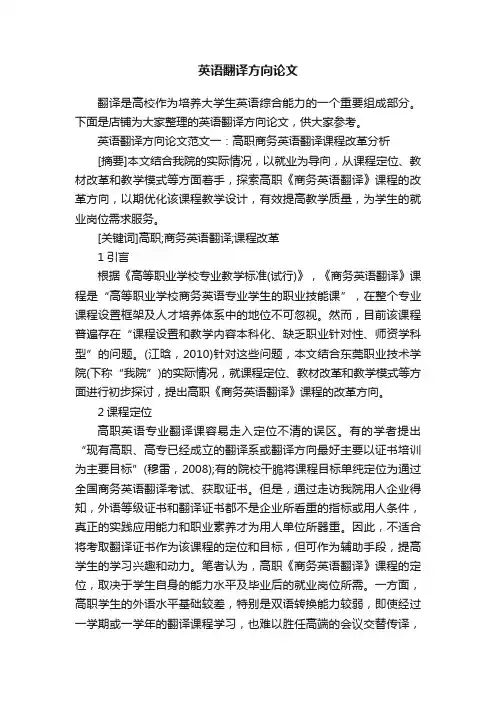
英语翻译方向论文翻译是高校作为培养大学生英语综合能力的一个重要组成部分。
下面是店铺为大家整理的英语翻译方向论文,供大家参考。
英语翻译方向论文范文一:高职商务英语翻译课程改革分析[摘要]本文结合我院的实际情况,以就业为导向,从课程定位、教材改革和教学模式等方面着手,探索高职《商务英语翻译》课程的改革方向,以期优化该课程教学设计,有效提高教学质量,为学生的就业岗位需求服务。
[关键词]高职;商务英语翻译;课程改革1引言根据《高等职业学校专业教学标准(试行)》,《商务英语翻译》课程是“高等职业学校商务英语专业学生的职业技能课”,在整个专业课程设置框架及人才培养体系中的地位不可忽视。
然而,目前该课程普遍存在“课程设置和教学内容本科化、缺乏职业针对性、师资学科型”的问题。
(江晗,2010)针对这些问题,本文结合东莞职业技术学院(下称“我院”)的实际情况,就课程定位、教材改革和教学模式等方面进行初步探讨,提出高职《商务英语翻译》课程的改革方向。
2课程定位高职英语专业翻译课容易走入定位不清的误区。
有的学者提出“现有高职、高专已经成立的翻译系或翻译方向最好主要以证书培训为主要目标”(穆雷,2008);有的院校干脆将课程目标单纯定位为通过全国商务英语翻译考试、获取证书。
但是,通过走访我院用人企业得知,外语等级证书和翻译证书都不是企业所看重的指标或用人条件,真正的实践应用能力和职业素养才为用人单位所器重。
因此,不适合将考取翻译证书作为该课程的定位和目标,但可作为辅助手段,提高学生的学习兴趣和动力。
笔者认为,高职《商务英语翻译》课程的定位,取决于学生自身的能力水平及毕业后的就业岗位所需。
一方面,高职学生的外语水平基础较差,特别是双语转换能力较弱,即使经过一学期或一学年的翻译课程学习,也难以胜任高端的会议交替传译,更不用说同声传译,只适合进行初级的口、笔译工作;另一方面,就我院以往毕业生的就业情况来看,没有专门从事翻译行业的专职译员,所以不能照搬培养专职译员的外语专业本科或研究生人才培养模式来对高职学生进行教学,而应该按实际情况来做出切实的课程定位,以指导该课程的开展,培养毕业生工作所需的相应翻译能力。
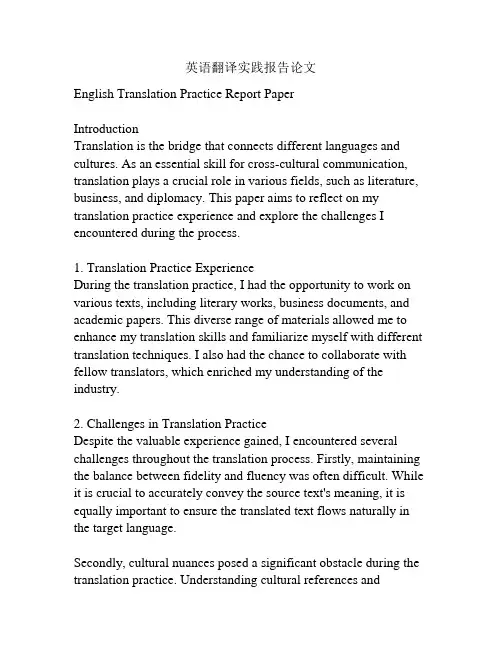
英语翻译实践报告论文English Translation Practice Report PaperIntroductionTranslation is the bridge that connects different languages and cultures. As an essential skill for cross-cultural communication, translation plays a crucial role in various fields, such as literature, business, and diplomacy. This paper aims to reflect on my translation practice experience and explore the challenges I encountered during the process.1. Translation Practice ExperienceDuring the translation practice, I had the opportunity to work on various texts, including literary works, business documents, and academic papers. This diverse range of materials allowed me to enhance my translation skills and familiarize myself with different translation techniques. I also had the chance to collaborate with fellow translators, which enriched my understanding of the industry.2. Challenges in Translation PracticeDespite the valuable experience gained, I encountered several challenges throughout the translation process. Firstly, maintaining the balance between fidelity and fluency was often difficult. While it is crucial to accurately convey the source text's meaning, it is equally important to ensure the translated text flows naturally in the target language.Secondly, cultural nuances posed a significant obstacle during the translation practice. Understanding cultural references andexpressions is essential to accurately convey the intended meaning. However, some cultural elements may lack equivalent equivalents, requiring a creative and context-based approach.Lastly, time management is a vital aspect of translation practice. Meeting deadlines without compromising the quality of the translation demanded careful planning and efficient time allocation.3. Strategies and SolutionsTo tackle the challenges mentioned above, I incorporated various strategies during my translation practice. Firstly, extensive research on the source text's cultural background and context helped me grasp its underlying meaning and effectively convey itin the target language.Secondly, actively seeking feedback from experienced translators and language professionals proved to be immensely helpful. Engaging in discussions about translation choices and receiving constructive criticism allowed me to refine my skills and broaden my understanding of different translation methods.Lastly, honing my time management skills allowed me to deliver quality translations within the set deadlines. Planning out each translation project and setting realistic goals ensured a smooth and efficient workflow.ConclusionTranslation practice is a valuable opportunity to improve translation skills and gain practical experience. Although challenges exist, such as finding the balance between fidelity andfluency, understanding cultural nuances, and managing time effectively, employing effective strategies can help overcome these obstacles. With continued practice and learning, translators can enhance their abilities and contribute to effective cross-cultural communication.。
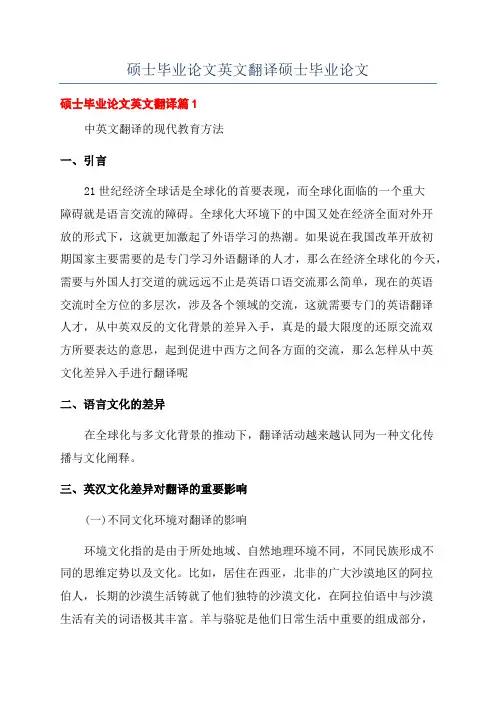
硕士毕业论文英文翻译硕士毕业论文硕士毕业论文英文翻译篇1中英文翻译的现代教育方法一、引言21世纪经济全球话是全球化的首要表现,而全球化面临的一个重大障碍就是语言交流的障碍。
全球化大环境下的中国又处在经济全面对外开放的形式下,这就更加激起了外语学习的热潮。
如果说在我国改革开放初期国家主要需要的是专门学习外语翻译的人才,那么在经济全球化的今天,需要与外国人打交道的就远远不止是英语口语交流那么简单,现在的英语交流时全方位的多层次,涉及各个领域的交流,这就需要专门的英语翻译人才,从中英双反的文化背景的差异入手,真是的最大限度的还原交流双方所要表达的意思,起到促进中西方之间各方面的交流,那么怎样从中英文化差异入手进行翻译呢二、语言文化的差异在全球化与多文化背景的推动下,翻译活动越来越认同为一种文化传播与文化阐释。
三、英汉文化差异对翻译的重要影响(一)不同文化环境对翻译的影响环境文化指的是由于所处地域、自然地理环境不同,不同民族形成不同的思维定势以及文化。
比如,居住在西亚,北非的广大沙漠地区的阿拉伯人,长期的沙漠生活铸就了他们独特的沙漠文化,在阿拉伯语中与沙漠生活有关的词语极其丰富。
羊与骆驼是他们日常生活中重要的组成部分,是赖以生存的工具。
所以阿语中有关羊的名称很多,骆驼的名称更是多得惊人,据统计,阿语中的骆驼及与骆驼有关的事物名称共5644个。
玛雅人是中美洲印第安人的一个种族,他们常年生活在热带地区,一年当中只有两个季节,即旱季(laèche)和雨季(l’humide),所以在玛雅语中就不会出现通过温度、降雨量等差别来区分的“四季”“春、夏、秋、冬”(quatreaion,leprintemp,l’été,l’automne,l’hiver)这样的气候词语。
显然一个民族,一个国家的地理条件在不同程度上对文化以及语言发展起着很重要的作用。
如果不深入了解译语国环境文化,就会造成翻译的非等值,继而不能达到文化传真的目的。
本科毕业论文关于英文翻译自改革开放以来,不同国家的人急于了解他国的文化,电影作为跨文化交流的一种方式,为电影界迎来了春天。
下文是店铺为大家整理的关于本科英文翻译毕业论文的范文,欢迎大家阅读参考!本科英文翻译毕业论文篇1英文电影片名翻译初探摘要:电影作为一种艺术形式,深受大众喜爱。
国与国之间的文化交流,电影也是一个重要组成部分。
把国内的好影片介绍出去,把国外的好影片引进来,翻译是重要一环,而首先吸引观众的就是片名。
片名的翻译起着重要的作用。
翻译片名,要以传递信息和唤起美感为目的。
在文字转移过程中,应切实保留原作的信息价值和美学价值。
既要忠于原片内容,还要注意文字优美、言简意赅,具有强烈的吸引力和感染力,本文针对目前英文电影片名翻译的现状,对英文电影片名翻译的有关理论展开讨论,同时提出了翻译片名的几种基本方法。
关键词:电影;英文电影;片名翻译;方法电影是人们喜闻乐见的艺术形式,它能传播信息、抒发感情、反映丰富多彩的生活。
给人们带来艺术上的享受。
一部好的影片之所以能吸引成千上万的观众,除了演员的精湛演技、富有哲理的对话以及绚丽多彩的画面外,与其寓意深刻、回味无穷的片名有着直接的联系。
片名,是影视片的品牌商标,看似简单却是作者颇费神思的产物,寥寥数词凝聚着整个作品的精髓。
电影片名翻译是一项重要而富于创造性的工作。
佳译能够为影片锦上添花。
对丰富国内观众业余文化生活,促进国际间文化艺术交流起到不可忽视的作用。
翻译片名大多直译,形式与内容皆相似,朴实明了又贴切。
但是片名的翻译也是语际交流,是不同文化之间的交流。
观众对象不同,文化和欣赏习惯也有差异,原语与译语的表达方式和习惯有同有异。
片名翻译时,也应深入理解影片的内容蕴涵和风格,揣摩措词用语,力求准确把握原语与译语的表层意义和联想意义,既要考虑对等,更要考虑到译名的传意性和可接受性。
一、英文电影片名翻译现状(一)一片多名的问题日前,电影片名翻译中存在着混乱、不规范的现象,一片多名的问题较突出。
关于英语翻译方向的论文范文翻译在跨文化、跨民族之间的交流和合作中功不可没,英语翻译,它既是语言之间的相互转换,同时也是不同文化间的交流。
下文是店铺为大家整理的英语翻译的论文的范文,欢迎大家阅读参考!英语翻译的论文篇1文化空缺与英汉翻译摘要:不同民族的语言产生于不同的文化背景,所承载的文化也不尽相同,这就必然导致两种语言在表达方式上存在很多相异之处,文化空缺就是这些差异的极端表现,它是一个民族语言和文化与其它民族语言和文化的异质性的充分体现,这无疑增加了翻译的难度。
所以文化空缺的翻译不仅是语言的迁移,更是文化的传播。
关键词:文化空缺英汉翻译翻译作为人类最早进行的交流活动之一,一直在不同的语言集团间沟通信息,对人类社会的发展和进步有非常重要的作用。
正是由于翻译所起的中介作用,民族间才可以互通有无、互相学习、共同发展。
跨文化交际学和文化语言学的兴起与发展,为语言与文化的研究带来了勃勃生机。
而作为跨文化交际的翻译,也因此而更加受到重视,对它的研究也呈现出多角度、多侧面、开放性的特点。
翻译作为不同语言之间人们交流思想和文化不可或缺的手段,在传播文化信息、促进不同民族间的相互了解与民族融合的过程中的重要作用已日益凸显。
翻译界对翻译理论研究的重心从译意到译信息再到以文化为导向的翻译,正说明翻译实质是文化的翻译。
如Bassnet & Lefevele就指出翻译的研究实际上就是文化互动的研究,Nida亦强调译者的双文化能力。
而在交流与翻译活动过程中,各民族由于语言文化异质性的客观存在,会不可避免地出现信息交流的障碍。
其中作为语言文化异质性极致体现形式的文化空缺现象更使交流者进入了两难的境地。
为积极应对空缺现象带来的问题,促使交流与翻译的顺利进行,就必须在交流与翻译过程中逐步探寻处理文化空缺的有效途径和办法。
翻译,在古时候叫做“象寄”或“通事”。
《说文解字》里说:“传译四夷之言者。
”《义疏》里也提到:“译即易,谓换易言语使相解也。
翻译英语毕业论⽂范⽂3篇英语毕业论⽂:论功能翻译理论摘要:中国传统翻译理论只有宏观的论述,缺乏⽅法论,操作性不强。
本⽂简述了功能翻译理论,详细地探讨了该理论的理论基础,并⽤关联理论予以论证,丰富了它的内容。
关键词:功能翻译理论;基础理论;阐释Abstract:Chinesetraditionaltranslationtheoryconsistsonlyoftranslationprincipleswithoutconcretemethodologyanditcannotbeappliedtopracticaltranslating.Thispapergivesabriefaccounttofunctionaltranslationtheory,prob Keywords:functionaltranslationtheory;basictheory;exposition功能翻译理论强调,翻译是⼀种特殊的交际形式,涉及三种⽂本:原语⽂本、译者的图式⽂本和译语⽂本。
对于原语⽂本,最重要的是抓住作者的修辞功能正确理解原语的修辞功能,是产⽣理想的图式⽂本的关键。
⽽正确把握原⽂的认知图式⼜是正确理解原⽂修辞功能的基础。
理想的图式⽂本来⾃原⽂的认知图式,来⾃对原⽂作者的修辞意图的准确把握。
在这个图式⽂本的基础上,产⽣怎样的译语⽂本,除了修辞功能等值之外,还应该考虑翻译的⽬的和读者对象。
⼀、功能翻译理论简述(⼀)、功能翻译理论的要点根据杂志上发表的论⽂、学术会议上宣读的论⽂、学术报告和出版的专著,功能翻译理论的要点简述如下:1、分析概念段(conceptualparagraph,具有明确主题意义⼀个或多个⾃然段)和句⼦的修辞功能,使修辞功能的形式重现,从形式的等同中求得功能的等值,意义的等值,这种翻译叫做功能翻译。
翻译应该是在修辞功能等值的前提下,遵守“信、达、X”规范;⽂体不同,翻译的⽬的不⼀样,X不⼀样。
【关键字】论文English Novel Title Translation: A Skopostheorie Perspective英语小说标题的翻译:一个Skopostheorie透视图The Translation of Fuzziness in the Dialogue of Fortress Besieged from the Perspective of Relevance Theory翻译的模糊性的对话《围城》从关联理论的角度On Domestication Strategy in Advertisement Slogan Translation在归化策略在广告口号的翻译Reproduction of “Three Beauties” in the Translation of the Poems in The Journey to the West繁殖的“三美”翻译的诗歌在西游记A Comparative Study of Interjection Translation in Teahouse from the Perspective of Functional Equivalence一个比较研究,在茶馆的感叹词翻译功能对等的角度Public Signs Translation from the Perspective of Functionalist Theory -- as an Example公共标志的翻译的角度,从实用主义的理论——以邵阳城市作为一个例子The Application of Skopostheory in the Business Advertisement TranslationSkopostheory的应用在商业广告翻译Relevance Theory Applied in the Translation of Neologism关联理论应用于翻译的新词Domestication and Foreignization in the Translation of Tourist Texts归化和异化在翻译旅游文本A Comparative Study of the Two English Versions of Lun Y u by James Legge and Ku Hongming from Translator's Subjectivity一个比较研究的两个英文版本的Lun Yu詹姆斯Legge和Ku Hongming从译者的主体性On the Translation and Functions of Metaphor in Advertisements在翻译和函数中隐喻的广告C-E Translation of Film Titles from the Perspective of Adaptation Theory汉英翻译的电影片名的角度,从适应理论Pun Advertisements Translation From the Perspective of Adaptation Theory广告双关语翻译的角度,从适应理论Analysis of the Translation Strategies of the Culture-loading Words in the English Version of Journey to the West分析的翻译策略在英语文化加载字版的西游记On Business Letter Translation under the Guidance of Conversational Implicature Theory在商务信函翻译的指导下,会话含义理论On the Translation of Puns in English Advertising在翻译双关语在英语广告Advertising Translation in the View of Skopos Theory广告翻译目的论的观点A study on Trademark Translation from the Perspective of Reception Aesthetics商标翻译的研究从接受美学的角度On the Audio-visual Subtitle Translation of Kung Fu Panda 2 from Skopostheorie Perspective在视听影视字幕翻译的《功夫熊猫2》从Skopostheorie透视图Cooperative Principle and Negative-information Business Letters合作原则和负面信息商务信函On Influence of Chinese Culture on Imagism of America—A Case Study of Pound’s Poems在中国文化的影响在美国意象派——案例研究庞德的诗歌The Translation of English Animal Idioms in the Perspective of Pragmatic Equivalence英语动物习语的翻译的语用等效的角度On the Improvement of English-Chinese Interpretation from the Perspective of Comprehension and MemoryOn Creative Treason and Its Relationship with Fidelity in Literary Translation在创造性叛逆和它的关系,文学翻译中忠实A Brief Look into Conceptual Metaphor—A Case Study of the Poems Selected from A Dream of Red Mansions一个简短的调查概念隐喻一个案例研究的诗歌选自《红楼梦》The Translation of Subtitles in "Desperate Housewives" from the Perspective of Functional Equivalence字幕的翻译在“绝望的主妇”从功能对等的角度An Analysis of Shi Xiaojing’s Translation of Camel Xiangzi Based on Reception Theory施小菁的分析翻译的骆驼祥子》基于接受理论A Study on Zhang Peiji's Translation of Modern Chinese Prosefrom the Perspective of Translator's Subjectivity研究张Peiji现代汉语Prosefrom翻译的译者主体性的视角The Translation of Wang Wei's Works From the Perspective of"Three Beauties" Principle王伟的翻译作品的角度,从“三美”原则English Passive Voice and Its Application to Translation英语主动语态和它的应用程序来翻译Metaphor Translation from the Perspective of Aesthetics--A Case Study of the English Version of Li Bai’s Poems隐喻的翻译从美学角度出发,一个案例研究的英语版本的李白的诗Domestication and Foreignization in Allusion Translation in Hongloumeng归化和异化的翻译在Hongloumeng典故English Translation of Hunan Tour Commentary from the Perspective of Intercultural Communication英语翻译的湖南旅游解说的角度,从跨文化交流The Application of Functional Equivalence Theory in Chinese-English Lyric Translation应用程序的功能对等理论对汉英翻译歌词On the Cultural Discrepancies of Color Terms Between English and Chinese and Their Corresponding Translating Strategies在文化差异的英语和汉语之间的颜色词及其相应的翻译策略On the Style of Zhang Peiji's Prose Translation在张的风格的散文翻译PeijiA Functionalist Approach to Advertising Translation一个实用主义的方法对广告翻译C-E Business Contract Translation under the Guidance of Skopos TheoryOn Allusion Translation under the Guidance of Relevance Theory---A Case from Lin Yutang's Six Chapters of a Floating Life 在典故翻译的指导下,关联理论———案例从林语堂的六章的一个浮动的生活A Study on C-E Trademark Translation from the Perspective of Cultural DifferencesOn Violation of Cooperative Principle in Subtitle Translation of Ice AgeOn the English Translation of Hunan Cuisine from cultural AspectsOn the Feasibility of "Three Beauties" Principle in Tang Poetry TranslationOn the Translation of Subjects in Chinese-English TranslationOn the Translation Strategies of Lang Tuteng from the Perspective of Domestication andForeignizationMetaphor Translation from the Perspective of Relevance TheoryBeauty of Chinese in Translated Lyrics of the English Pop SongsThe Different Styles of Translation in Rush: From the Choice of WordsTranslation of Scenery Description in Tourist Text in Hunan in Cross-culture CommunicationOn E-C Translation of Puns in Advertising from the Perspective of SkopostheorieE-C Translation of Cartoon Subtitle from the Perspective of Skopostheorie——A Case Study of Ic e AgeOn C-E Translation of Scenery Spots Introduction in Hunan Province from Cultural PerspectiveDomestication and Foreignization in C-E Translation of Four-Character Idioms On C-E Translation of Hotel Introduction in Hunan Province from the Perspective of SkopostheorieE-C Translation of Business Letters—From the Perspective of Nida’s Functional Equivalence TheoryA Skopos Study on the Translation of Report on the Work of the Government 2011On English-Chinese Translation of Business Correspondence from the Perspective of Skopos TheoryUniversals of Translation and Zhang Peiji's Selected Modern Chinese ProseOn Xu Yanchong’s Translation of 300 Tang Poems from the Perspective of Aesthetics Reception TheoryOn Subtitles Translation of Humorous Dialogues in Friends from the Perspective of Functional EquivalenceAn Elementary Study on Chinese to English Soft News Translation: from the Perspective of Nida's Functional-Equivalence Translation TheoryAn Elementary Study on Brand Name Translation--from the Perspective of Peter Newmark's Communicative Translation TheoryA Study on Gu Zhengkun's Translation of Shakespeare's Sonnets-- from the Perspective of SkopostheorieApplication of the Functionalist Translation Theory in Film Title TranslationA Study on the Translation of Idioms Between English and Chinese from the Perspective of Functional EquivalenceA Study of Chinese Menu Translation from the Perspective of Foreignization and Domestication On Translation of Brand Names from the Perspective of AdaptationOn English Translation of Li Bai’s peotry in the Light of Functional Equivalence Theory The “Equivalence” and “Aestheticism” in Trademark TranslationOn Culturally Loaded English Idioms and Their Translation此文档是由网络收集并进行重新排版整理.word可编辑版本!。
英语专业毕业论文翻译方向英语专业毕业论文翻译方向随着全球化的发展,英语专业毕业论文翻译方向成为越来越多学生选择的方向。
翻译作为一门语言学科,不仅需要掌握语言的基本知识,还需要具备一定的文化素养和专业背景。
本文将从翻译的定义、翻译方向的选择、翻译技巧和翻译的前景等方面进行探讨。
首先,翻译是将一种语言转化为另一种语言的过程。
翻译的目的是为了使不同语言之间的信息得以传递和理解。
翻译的难度在于不同语言之间的差异,包括语法、词汇、语义和语用等方面。
因此,翻译需要翻译者具备良好的语言能力和跨文化交际能力。
在选择翻译方向时,应根据个人的兴趣和专业背景进行选择。
英语专业毕业论文翻译方向可以包括文学翻译、商务翻译、法律翻译、科技翻译等。
文学翻译要求翻译者具备良好的文学素养和文化背景,能够准确传达原文的意境和风格。
商务翻译要求翻译者具备商务知识和跨文化交际能力,能够准确传达商务文件和会议内容。
法律翻译要求翻译者具备法律知识和专业术语的掌握,能够准确传达法律文件和合同条款。
科技翻译要求翻译者具备科技知识和专业术语的掌握,能够准确传达科技文献和研究成果。
在进行翻译时,需要掌握一些翻译技巧。
首先,要注意语言的准确性和流畅性。
翻译不仅要准确传达原文的意思,还要使译文符合目标语言的语法和习惯用法。
其次,要注意文化的适应性。
不同语言和文化之间存在差异,翻译者要根据目标读者的文化背景进行适当的调整。
再次,要注意上下文的理解和转化。
翻译不仅要理解句子的表面意思,还要理解句子的语境和语用功能,以便进行准确的转化。
英语专业毕业论文翻译方向具有广阔的前景。
随着全球化的深入发展,跨国公司和国际组织对翻译人才的需求越来越大。
翻译人才不仅可以从事翻译工作,还可以从事口译、笔译、翻译管理、翻译教学等相关工作。
同时,随着互联网的普及,网站翻译和软件翻译也成为热门的翻译方向。
因此,选择英语专业毕业论文翻译方向将为学生提供广阔的就业机会和发展空间。
总之,英语专业毕业论文翻译方向是一门既有挑战性又有前景的学科。
英语翻译硕士生毕业论文翻译是将一种语言所表达的思想内容,全面、忠实、流畅地转换成另一种语言,英语翻译对于我们来说具有一定的难度。
下文是店铺为大家整理的关于英语翻译硕士生毕业论文的范文,欢迎大家阅读参考!英语翻译硕士生毕业论文篇1浅议实用英语翻译【摘要】本文探讨了实用英语翻译的理论和应用。
【关键词】实用英语翻译;看易写;模仿-借用-创新1.实用英语翻译的定位对于翻译的分类,有两种分法即将翻译分为文学翻译和非文学翻译。
按照这样的分类,给实用英语下的定义是“应用文体翻译以传达信息为目的(同时考虑信息的传递效果),它区别于传达有较强情感意义和美学意义的文学翻译。
”(方梦之,2003:47)德国翻译理论家Mary Snell-Hornby将翻译分为三类:文学翻译(Literary Translation),普通言语翻译(General Language Translation),以及专门用途言语翻译(Special Language Translation)。
(Mary Snell-Hornby,2001:32) 其中的普通言语翻译就是我们所说的实用英语翻译,包括新闻、广告、电影、公示语翻译等。
“三分法”对于促进实用英语翻译研究意义重大,以往学者都对文学翻译关注更多,“两分法”就是以文学翻译为重心和出发点的,将翻译分为文学,普通,专门之后,可以使学者平等地对待这三类翻译,促进它们共同发展,尤其对近几年来问题较多,亟待改善的实用英语翻译给予特殊的关注。
2.“信”与实用英语翻译赵元任先生在《论翻译中信、达、雅的信的幅度》一文中认为“信”是“翻译中的基本条件”,但是翻译中的“信”度受多种因素制约,“信”有很多幅度,如意义和功用上的幅度,直译和意译的幅度,必具的范畴,语言的音调等等。
其中意义和功用的幅度即照字义翻译和按功用翻译,照字义翻译能说明原文说了什么,而按功用翻译则是去做原文相同情境中要做的事。
他指出,同样一句话,按字面翻译和按同样情形下译入语国习惯说法来翻译,经常会出现两种截然不同的情况。
1. IntroductionBa Jin is an outstanding writer. He also is an excellent translator in Chinese literature history. His vision of The Happy Prince sell well in China in the past several decades. He has a sense of aesthetics in translation. The version translated by Ba Jin perfectly reflects his aesthetic thought. The version has simple wording, vivid image and fresh style. In recent years, more and more scholars have begun to focus on the translation of Ba Jin’s The Happy Prince . The thesis focuses on exploring Ba Jin’s version--The Happy Prince from strategies and features in translation.Through this study, it is found that translator should not omit the core of the origin text during the translation, on the contrary, the aesthetic information as its ultimate goal to be taken representative. This thesis will be helpful for those scholars who want a deep understanding about Ba Jin’s aesthetic thoughts on translation and stimulate people ’s interest to the aesthetic translation. By summing up experience and lessons learned in this field, more and better works will be published.2. Translation AestheticsAesthetics is a philosophical branch of inquiry concerned with beauty, art and perception. Translation aesthetics has a long history. There are few points about translation aesthetics. Liu (2004: 45) thinks that “the formal system is constituted by physical, natural properties and external components that directly build up images ” . Mao (2005: 97) discusses few topics about beauty in his book, including the beauty of sounds, the magic words, emotion, and so on . He defines the Translation Aesthetics is the study on aesthetic subject, aesthetic object and the aesthetic activities in Translation Aesthetics, this is the first time that translation aesthetics as the title in his book, he briefly reviewed the development history of Chinese translation aesthetics, concluded that “the basis of theory in traditional Chinese translation theory is aesthetics ”. Translation aesthetic object contains the original work and target work; translation aesthetic subject contains reader and translator; aesthetic activities have many details, including aesthetic judgments, aesthetic appreciation, creative aesthetic representation and so on.Liu (2004: 78) pointed out that “the combination of translation theory and artistic aesthetics is the basic characteristics of Chinese traditional translation theory ” in his book, [1][2] [1]in which he analyzes the aesthetic subject and aesthetic object briefly. Translation is a progress, including comprehension, transformation and improvement.2.1 Aesthetic SubjectNida (1963: 45) said “Translator is the aesthetic subject. A good target text not only has a bearing on the aesthetic constituents of its aesthetic object, but also has a bearing on the aesthetic subject ’s ability. When they are both in the integrating aesthetic relationship, translating, as the progression of aesthetic representation, should be endowed aesthetic effect” . Fu (1993:79) states that there are two aesthetic subjects during translating work--translator and receptor . Translator plays a very important role in translation. Aesthetic subjects refer to those people who can make judgment under the specific condition. Aesthetic subject is called “second reality ” by Tytler (2009: 32) because it is different form reality, and it has two types: translators and readers. Translator is the aesthetic subject of origin works, while reader is the aesthetic subject of the target works. Translators play a crucial role in translation. Translator should understand the works first, and then transform the meaning to target works. Translator is a active part in aesthetic translation. Considering the receptors, Mark (1997: 124) thinks that translator not only transform the main meaning to target work, but also aestheticconsciousness, culture accomplishment and aesthetic experience .Lao Zi (1999: 223) holds translator is the aesthetic subject of target text, he plays a very important role in perceiving, judging and evaluating original text and transforming every detail into target text, the deeper he understands the original text, the higher the quality oftranslation work would be.Liu (2004: 35) thinks that the translator should start translating work from the children ’sangle . So it is indispensable that the translator to master three aesthetic conditions: aesthetic consciousness, culture accomplishment and aesthetic experience .(1) aesthetic consciousnessAesthetic consciousness refers to the perception of aesthetics or a sense of aesthetics, they are from translator ’s instinct. In children ’s world, everything is so quite and simple, everyone is so friendly, their thoughts are very different from adults ’. If children think the world is imbalance after reading a book, the book is not a good one.(2) culture accomplishment[3][4] [5] [6] [7] [1]A good translator should have original language knowledge, target language knowledge and other related professional knowledge. As a translator of children ’s literature, the necessary knowledge is to know characteristics at different ages. If the translator apply children ’s language for adult, it should be very ridiculous to read such a translated work.(3) aesthetic experienceAs a translator, he must have enough vocabulary as well as syntactic resources, and he can use them flexibly in different situations. During translating works, translators should master translation methods, which will be helpful to make him acquire his aesthetic experience. For translators, aesthetic experience is quite important, especially in the translation of children ’s literature.Reader can be divided into two types-- adult and children. As readers, they are quite different. Adults have their own aesthetic standards. During reading works, they won’t accept the information from target works. Because they are capable of judging, evaluating and appreciating what they read. Also they can comprehend the knowledge that they have never heard, Their experience and relevant knowledge offer translators convenience to translate target works. While children are quite different from adults, children like literature which describe truth, beauty, honesty and kindness. They think that it is full of peace and love in the world around them. Children are curious, they will pay all their attention to new scene or environment, no matter it is bad or good.2.2 Aesthetic ObjectAccording to Liu’s (2004: 35) opinion, aesthetic object refers to source text [1]. Itsaesthetic values should be founded upon its aesthetic constituents. There are two categories, one is aesthetic superstratum elements, which refers to the features of the form of a language such as the characteristics of its phonology, lexicon and syntax. It is called the beauty of form in aesthetics, such as image, style of source text. It could be perceived directly. The other constituent is non-superstratum. There is no direct relationship between it and linguistic form. E (1978)has quite different idea from Liu (2004), he thinks that aesthetic object includessource text and target text. As real reflection of the reality, aesthetic object is called “third reality ”by Zhi (2006). Aesthetic objects can cater to people ’s aesthetic needs. Liu (2004) divided aesthetic objects into two terms: form system and non-form system. [8] [9] [1]Form system has two salient features. Firstly, it relates to susceptible feelings. Secondly, that form is a complicated conception.According to Liu’s opinion(2005),the non-form aesthetic constituents can be divided[1]into four scopes:sentiments,ideals, images and symbols .3. Ba Jin’s Aesthetic Thoughts in TranslationAs we all know, Ba Jin’s works are the solid foundation in Chinese literature,as a famous novelist in literary world, he has abundant aesthetic thoughts on translation. He provides lots of works for us. But few scholars pay attention to his aesthetic thought. He is famous for his novel in the modern literature world. Literature world pays more attention to his works at the beginning of his creation. But the study on his aesthetic thought in his novel has not been given sufficient attention. It is necessary to explore and summarize Ba Jin’s aesthetic thought. Ba Jin’s translation benefits from his extensive knowledge.Through the translation practic on children’s literature, Ba Jin acquires a lot precious experience, also he has a childlike heart, which makes children bound up in his works. All these experiences make him to become a first-class translator,and to achieve a great success in translation.3.1 Ba Jin’s Career as TranslatorBa Jin is a writer, also is a productive translator. All people know him as the writer's identity, but few people know his identity as a translator. He had built numerous characters. What he does in translation and writing pushes him to be an outstanding scholar. Many foreigners seek advice form him constantly. Ba Jin’s aesthetic thought in translation in the process of his translation work come from his accomplishment in Chinese language and English language,his rich experience and writing talent,his unassumingness and perseverance,etc...Generally speaking, all of these qualities play a crucial role in the comprehension and replication of aesthetics in The Happy Prince.Ba Jin has the idea of translating The Happy Prince few decades age, but he just didn’t dare to start. He decides to start the translation work in middle March of 1942. In the rest time of 1942, Ba Jin finished a portion of translation, three short stories--The Selfish Giant, The Happy Prince and The Nightingale and the Rose. After that moment, he was disappointed to his own translation, so he lost confidence suddenly. The more worse thing happened during the war in 1944, his handwriting were burned after he put them back to the bookrack. Ba Jin didn’t give up, he started again in 1946, two years later, he ultimately finished the translating.Thinking back, we can notice that the new start is good for the translation, because he became more mature in choosing words and dealing with the different cultures than the first time, also he had a deep understanding to the source work during such a long time. Ba Jin is worthy of our respect,no matter as a writer or translator.3.2 Ba Jin’s Aesthetic Translation ThoughtsThere is no standard for the definition of children’s literature,it has its own characteristics. Firstly, the details in children’s literature are dramatic and easy to understand, story lines are beneficial for promotion of the children’s interests, wit and taste.Secondly, children’s literature has an education function. Its language is meaningful,simple stories illustrate the profound truth. Thirdly, children are the target receiptor of children’s literature, so the language should be full of childlike innocence.In this way, can the works win the favor of children,to attract more readers.Children’s literature is quite different from adult literature.The former needs more special attention. Through years study in translation and language,Ba Jin has his own untouchable thoughts on translation.3.2.1 Ba Jin’s Language Features in TranslationWhen people talk about Ba Jin’s translation, they always concern with literal translation. Ba Jin shows children’s world on different levels.Firstly of all,Ba Jin’s language is very simple and colloquial. Children’s literature has become a hot topic in recent years. More and more translators and writers have realized that receiptors preferred to hear the sound of words and phrases. To meet the needs of children for rhythm and sounds,writers and translators try to make the language of their works sound nice, vivid and smooth. Ba Jin’s works are well-known, because some works written or translated by him are looked as stories. His wording is simple and easy to understand,readers,especially young readers feel familiar to the language,also it is benefit to understand other narration.Secondly,the most foregrounded during Ba Jin’s translation is the sound beauty. In children’s language,musical sound and noticeable characteristics are indispensable. We can find that there are so many interjection, exclamation and onomatopoeia in the conversation. Some writers and translators regard it as trivial or useless details, in fact, these elements are very important for translation. They are helpful to make the conversation more lively andinteresting, attracting more young readers. Ba Jin’s translation sets a good example in this respect.Lastly, Ba Jin focuses on the literal translation. He won’t omit every source language point. The target readers are European, so we can find Europeanized sentences in his works. These structures cause difficulties in understanding for children, however, as we all know, the readers and receiptors are not only the children, but also adults,it sounds reasonable.3.2.2 Ba Jin’s Aesthetic Attitude in TranslationThe aesthetic attitude is defined as the attitude to the aesthetic objects. It is influenced by many factors. One of the most factors is the inner desire and interest, it always exists in our minds.During the translation, the translators may extend the emotion or express his own sentiment if he love the original writer or this work, also he may take a quite initiative in the process of translation. Just as the excellent translator Roman(1959: 93) said, there are two standards to judge whether a translator is befitting to translate a original work. The first is wether the translator has interest in the source work, or the translator enjoys the source work;[10]The second standard is whether the translator has eyes to find every artistic element.Ba Jin says, he just chose those works which cater for his emotion or taste. His first translating is Signal,he has a great enthusiasm for this book, and his own sensibilities in it.Sometimes Ba Jin not totally goes along with the original authors, but every work is excellent in his eyes. He wants to open his heart to the readers through his own works and translation. Initially, Ba Jin was just trying to translate, while after he finished, he would be quite excited and very appreciate his own achievements.Wilde’s fairytales have few Significant features, such as beautiful and integrated style, the poetic language and the musical tone. Ba Jin was interested in them. He praised Wilde from the bottom of his heart. Wilde is a writer famous for his childlike language and his beautiful works, and he has his own characteristic style and rhetoric. Ba Jin said that he learned how to be a straight shooter after translating work.This positive aesthetic attitude to ensure Ba Jin's insistence, even in a bad situation he can modify his manuscripts and finish the translating.Ba Jin and Wilde hold a similar idea on the importance of the form, they both think thatform has a major influence on the literary.Ba Jin thinks that inferior should serve content, and he firmly believe that translators and writers in China never stop seeking for a form which can express their ideas freely. Wilde often regards form as the start point for the creation of works, the next one is ideas and then devotion. The form should be suitable for conveying original writer’s emotion incisively and vividly, attract more receiptors, and enhance the reader’s sense of aesthetics.A literature work can have many translators and countless readers. Every translator expresses his own aesthetic thoughts in his translating through his unique method. Each of them does their utmost to be faithful to the source work, but it cannot stop permeating the embodiment of personal judgment on aesthetics in translation. Ba Jin has his own principle in translation is that he tries his best to be faithful to the source work.Aa Jin focuses on the creative power during the translation.He has always insisted on the tone and style, this is the reason why so many people love Ba Jin’s visions.4. Ba Jin’s Aesthetic Translation in The Happy PrincePart three provides a brief introduction to Ba Jin as a translator, and his unique aesthetic thoughts in translation. In this part it is requisite to analyze Ba Jin’s achievement in translating works. Ba Jin translated version The Happy Prince is very popular in a period of time. Therefore,this study takes Ba Jin’s vision of The Happy Prince as an example to explore the aesthetics in the source work, to explore Ba Jin’s concrete manifestation of aesthetic elements in his vision,and how he takes aesthetic enjoyment to target readers.In fact, the key point of translation work is to make the target text to the maximum extent similar with the original text in aesthetics. No translator can produce a perfect text.If an imperfect to be a consummate one by translating,it is regarded as a palimpsest,not translation. In Yan’s opinion (1998: 167), aesthetic thoughts can be embodied in many ways, such as the Nationalization issues of the beauty of form; the filiation between national cultures and the beauty of form; the relation between form and content; how to make the aesthetic ideality to[11]be specific things .Before explore the aesthetic thoughts in translation, it is helpful to analyze the aesthetic features in The Happy Prince. For clarity,this thesis probe into the aesthetic thoughts in Ba Jin’s vision from three aspects: poetic language,image and style, these aspects are interdependent to each other in an organic whole and even overlap in some cases.4.1 Representation of the Poetic Language of The Happy PrinceIn literary art, scholars always regard language as the vehicle. Readers are attracted by literary language firstly when read writings. If the art cannot attract reader’s attention with best story and original concept, it indicates that there is no good nguage is like outerwear of writings, it contains words, phrases, sentence, paragraphs and discourses. There are many details in the process of expressing aesthetic thoughts and showing the original images, such as grammar,sentence structure and logic and so on.Beauty of language is determined by many aspects, including the choosing of words, sentence patterns and other linguistic expressions. A complete translation starts from original text and ends up with target text, so the transfer process of aesthetic thoughts is also from the original text to the translation. The external aesthetic elements are regarded as the form of language,the connotative aesthetic elements are content. The content contains not only the meaning,tone and sound,but also lingering charm and mood.4.1.1 Features of Language in The Happy PrinceIn Wilde’s fairytales, the most prominent feature in language is smoothness. In Ba Jin’s vision of The Happy Prince, there is a prominent feature is poetic language, no matter in describing a scene, telling a scenario, or making a dialogue, the language is always vivid and smart.There are five stories in The Happy Prince--The Nightingale and the Rose; The Selfish Giant; The Devoted Friend and The Remarkable Rocket.They are all filled with fantastic imagination and delicate sarcasm with simple colloquial language. All these cater for tastes of children and adults. Ba Jin owns a good language foundation and rich writing and has a very high capacity in comprehending the original text and applying target language.All these advantages have a promoting effect on Ba Jin’s translating work. He transfers the beauty of original text at utmost to the vision of The Happy Prince. The beauty in the original language gets represented in the largest degree in his version of The Happy Prince.4.1.2 Specific Representation of Language in The Happy PrincePeople who read this book will be deeply touched by its story, like The Nightingale and the Rose, this story focuses on the representation of the process in which the nightingale pressed her breast against the thorn all night to make a red rose with her blood for the student she loved.......“Swallow, Swallow, little Swallow,” said the Prince, ‘”will younot stay with me for one night, and be my messenger ? The boy is so thirsty,and the mother so sad” (Oscar Wilde1996:165) .......“燕子,燕子,小燕子,”王子要求说,“你难道不肯陪我过一夜,做一回我的信差么?那个孩子咳得太厉害了,他的母亲太苦恼了”(巴金 2010:202) 。